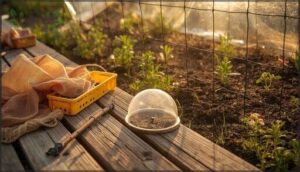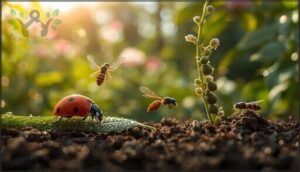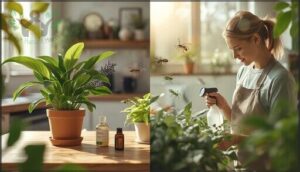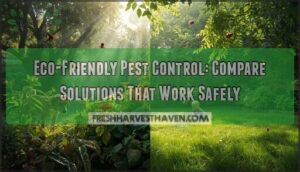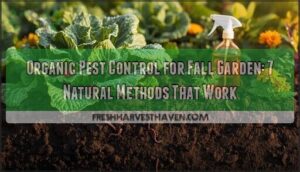This site is supported by our readers. We may earn a commission, at no cost to you, if you purchase through links.
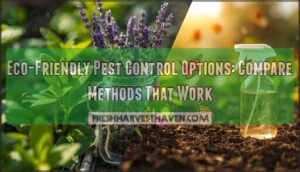
Physical barriers achieve 95% effectiveness in protecting beneficial species, while biological controls have reduced chemical dependency by over 40% in sustainable agriculture settings. The shift isn’t just about environmental consciousness; it’s driven by measurable results.
Microbial biopesticides suppress pests at rates between 75% and 90% without harming pollinators, and natural repellents like lemon eucalyptus oil deliver 95% mosquito protection for hours at a time.
If you’re weighing your options, understanding how these methods compare—in effectiveness, cost, and long-term sustainability—will help you choose the approach that protects your space without compromising safety or performance.
Table Of Contents
Key Takeaways
- Physical barriers and biological controls deliver 55–95% effectiveness without harming beneficial insects, while cutting chemical dependency by over 40% and supporting self-sustaining pest management that strengthens rather than disrupts your ecosystem.
- Eco-friendly methods protect your family from serious health risks linked to conventional pesticides—including cancer, neurological damage, and endocrine disruption—with children under six accounting for 50% of pesticide poisonings that happen primarily at home.
- Sustainable pest control reduces upfront costs by 20–30% per acre and delivers long-term savings through 70% lower carbon emissions, 30% reduced annual maintenance expenses, and prevention of costly resistance development that affects over 500 pest species.
- IPM strategies combining habitat modification, beneficial insects, and organic treatments maintain over 90% pest-free sustainability after three years while doubling pollinator populations and cutting reapplication needs by half compared to chemical approaches.
Comparing Eco-Friendly Pest Control Methods
When pests invade your space, you don’t have to reach for harsh chemicals to solve the problem. A range of eco-friendly methods can keep your home pest-free while protecting your family and the environment.
Let’s compare the most effective approaches so you can find what works best for your situation.
Physical and Mechanical Controls
Physical and mechanical controls—think sticky traps, exclusion methods, and habitat modification—keep pests out without chemicals. These IPM integration tools achieve 55% to 85% effectiveness in sustainable settings. Soil solarization heats soil to eliminate larvae and pathogens naturally. Barrier effectiveness reaches 95% in protecting non-target species, while robotic solutions cut manual labor by 30%.
These methods align with IPM principles that emphasize a combination of common-sense practices. Humane trapping and physical mechanical controls offer proven results you can trust.
Biological Controls and Beneficial Insects
Beneficial insects—ladybugs, lacewings, and parasitic wasps—act as nature’s pest control team, targeting aphids, whiteflies, and other invaders without harming your family or the environment. These biocontrol agents establish self-sustaining populations, offering continuous protection while supporting ecological balance. You’ll reduce chemical dependency by over 40% and strengthen soil health, making this IPM integration strategy both effective and sustainable for long-term pest management.
The global biological pest control market is projected to exceed USD 15 billion by 2033, reflecting a 12% annual growth rate. The market is seeing growth due to increasing use of predators.
Natural Repellents and Deterrents
While beneficial insects handle pests directly, natural repellents and deterrents create protective barriers using plant-based ingredients like lemon eucalyptus oil, which delivers 95% mosquito repellency for three hours.
Technological innovations—microencapsulation extends protection by 200%—address adoption challenges like shorter duration compared to synthetic options.
Consumer trends show 53% of households with children prefer these eco-friendly pest control solutions despite safety advantages coming with trade-offs in longevity and standardization.
Organic Pesticides and Treatments
When repellents aren’t enough, organic pesticides like neem-based formulations and pyrethrins offer targeted pest control. Azadirachtin, the active compound in neem, disrupts insect growth at concentrations below 1 ppm, while spinosad provides longer residual control through ingestion-based mechanisms.
These plant-based ingredients degrade faster than synthetics, reducing soil contamination risks. However, organic efficacy varies—you’ll often need more frequent applications than conventional treatments.
The market’s responding: organic pesticides are projected to reach USD 7.2 billion by 2032, driven by regulatory restrictions and consumer preference for residue-free food.
DIY Natural Pest Control Solutions
You can make effective homemade repellents for under USD 2 per gallon using soap, vinegar, or essential oils. These DIY natural pest control recipes cost USD 10–30 per acre—among the lowest-cost organic garden solutions available. Recipe effectiveness varies, but microbial biopesticides show 75–90% pest suppression while protecting bees. Global adoption of natural pest control methods now exceeds 60% on farms implementing IPM strategies. Cost analysis confirms these solutions reduce pesticide expenses by 20–30% per acre while supporting biodiversity conservation goals through zero toxic residues.
Soap sprays achieve up to 90% contact efficacy against soft-bodied pests, while neem oil solutions reach 75–85% pest reduction. Essential oils like peppermint and citronella maintain 80% repellency rates in controlled trials with minimal environmental impact. Chili powder demonstrates 67% deterrence effectiveness against crickets, outperforming garlic-based natural repellents.
- Soap spray: Mix 1–2 teaspoons mild soap per gallon of water; reapply every 4–7 days for active infestations
- Chili powder: Demonstrates 67% deterrence effectiveness against crickets, outperforming garlic-based natural repellents
- Essential oils: Peppermint and citronella maintain 80% repellency rates in controlled trials with minimal environmental impact
Health and Safety Benefits of Green Solutions
When you’re protecting your home from pests, your family’s health comes first. Chemical pesticides can introduce risks you don’t need to take, especially when safer alternatives exist.
Let’s look at three key ways green pest control keeps your loved ones out of harm’s way.
Health Risks of Chemical Pesticides
Traditional pesticides pose serious health risks that you can’t afford to ignore. Chronic exposure links to cancer risks, including leukemia and lymphoma, while organophosphates disrupt brain function, causing neurological effects like cognitive decline and Parkinson’s disease.
These harmful chemicals act as endocrine disruptors, interfering with hormones and fertility. They also trigger immune suppression, leaving you vulnerable to infections, and contribute to metabolic disorders, including diabetes and cardiovascular disease.
That’s why nontoxic methods offer safer alternatives without compromising pest control effectiveness.
Child and Pet Safety Considerations
Because children under six account for roughly 50% of pesticide-related poisonings—90% happening at home—you need nontoxic methods prioritizing child and pet safety considerations. Kids absorb nearly twice the pollutants per pound compared to adults, while crawling infants contact pesticide residues on floors and carpets. Pets lick treated surfaces, increasing pet sensitivity risks through behavioral exposure pathways.
Children under six account for 50% of pesticide poisonings—90% at home—because they absorb twice the pollutants per pound and contact residues on floors, making nontoxic methods essential
Prevention practices like sealed entry points and safe alternatives such as beneficial insects eliminate pesticide exposure effects without compromising human safety or pet safety.
Minimizing Indoor and Outdoor Chemical Exposure
You control indoor air quality and chemical drift reduction when you adopt non-chemical controls—sticky traps, diatomaceous earth, and beneficial insects reduce pesticide residues by up to 70% without residual contamination.
Household practices supporting your eco-friendly shift include:
- Open windows for 30 minutes post-application to halve airborne pesticide residues within 24 hours
- Remove shoes at entrances to cut tracked pesticide dust by 60–80%
- Vacuum with HEPA filters weekly to reduce pyrethroid residues by 50%
Integrated Pest Management (IPM) minimizes health risks of pesticides while addressing environmental impact of pesticides through natural pest control and ecofriendly pest control strategies.
Environmental Impact: Green Vs. Conventional Approaches
When you choose pest control methods, you’re making a choice that ripples far beyond your home. Traditional pesticides can wreak havoc on ecosystems, while green alternatives work with nature instead of against it.
Let’s examine how these two approaches measure up across three critical environmental areas.
Effects on Beneficial Insects and Biodiversity
When you apply broad-spectrum pesticides, you’re basically carpet-bombing an ecosystem—beneficial insects fall just as quickly as pests. Neonicotinoids, for instance, cut bee pollination efficiency by 30–50%, while conventional spraying decimates ladybug populations by over 70% in treated fields.
Integrated Pest Management (IPM) flips this script entirely, reducing insecticide use by 95% while nearly doubling pollinator abundance through habitat management and biological controls. Organic pest control methods maintain healthy insect communities, bolster 25% higher diversity compared to chemical approaches, and prove that predator enhancement and pollinator protection aren’t just environmental luxuries—they’re practical strategies that deliver measurable results while preserving the natural allies your property needs.
| Approach | Impact on Beneficial Insects | Biodiversity Outcome |
|---|---|---|
| Conventional Pesticides | 50–80% reduction in non-target insect survival; 70%+ decline in ladybugs | Severe population crashes in pollinators within 3 km radius |
| Integrated Pest Management (IPM) | 99% increase in flower visitation; supports natural enemy diversity | Maintains ecosystem balance; doubles pollinator populations |
| Organic Methods | Eliminates toxic residues; 25% higher insect diversity | 40% reduction in non-target mortality; healthier communities |
| Habitat Management | 40–60% improvement in pest control from predator biodiversity | 45% increase in natural enemies; enhanced landscape complexity |
| Ecological Farming | Twice as many predators/parasitic insects in diverse vegetation | Long-term resilience through natural predator-prey balance |
Water and Soil Contamination Risks
Pesticide water exposure affects 100% of surveyed U.S. streams, while soil residue effects from organochlorines like DDT linger for decades, multiplying health risks through contaminated crops and groundwater. Organic risk reduction eliminates these hazards entirely—organic fields contain half the residues at nine times lower concentrations—while biopesticide runoff under proper contaminant containment poses minimal environmental impact compared to synthetics. Eco-friendly pest control safeguards both water contamination pathways and soil health through precision application and naturally derived solutions.
| Contamination Type | Conventional Pesticides | Eco-Friendly Methods |
|---|---|---|
| Water Contamination | Detected in 100% of surface water samples; 16 pesticides in all urban streams | Biopesticides show minimal off-site movement; near-zero aquatic persistence |
| Soil Residue Effects | Organochlorines persist decades; 2× more residues at 9× higher concentrations | Organic practices eliminate synthetic inputs; improved microbial diversity |
| Health Risks | Persistent compounds leach into aquifers; sediment contamination alters ecosystems | Natural repellents degrade rapidly; reduced exposure to toxic residues |
Long-Term Environmental Sustainability
Your immediate actions reduce exposure risks, but sustainable pest management determines whether ecosystems recover or decline over generations. Integrated Pest Management (IPM) cuts pesticide use by 50%, lowering emissions from 143 to 43 CO2e per acre—a 70% carbon footprint reduction that multiplies across landscapes.
Biological controls restore natural predator-prey cycles, boosting pollinator diversity 40–50% while strengthening soil health through microbial activity and nutrient retention. This ecosystem resilience translates to 25% faster recovery after outbreaks, proving that environmental stewardship through eco-friendly pest control isn’t just safer today—it’s resource efficiency that protects biodiversity and soil vitality for decades ahead.
| Environmental Factor | Long-Term Outcome |
|---|---|
| Carbon & Energy | 70% emission reduction; energy savings up to 70% over chemical methods |
| Biodiversity & Soil | 40–50% more beneficial insects; 30% higher microbial biomass and carbon storage |
| Ecosystem Stability | 25% faster pest outbreak recovery; sustained yields across multiple seasons |
Cost-Effectiveness and Long-Term Results
When you’re weighing eco-friendly pest control against conventional methods, the bottom line matters just as much as the impact on your family and the environment. The initial investment might look different, but the real story unfolds over months and years as you compare resistance issues, recurring treatments, and prevention strategies.
Let’s break down how green methods stack up financially and what you can expect for lasting results.
Upfront Costs Vs. Ongoing Savings
When you’re weighing eco-friendly pest control against conventional methods, the initial investment might run you $100–500 for a home setup, but long-term ROI generally kicks in within two to three seasons.
Integrated Pest Management (IPM) and prevention strategies cut annual maintenance expenses by up to 30%, while avoiding hidden costs like chemical disposal fees and environmental remediation that can hit $5,000 per incident.
Sustainable pest control delivers value retention by protecting your property from damage and reducing the need for costly reapplications as systems mature.
Resistance Development in Pests
Beyond the savings you’ll see upfront, sustainable pest control helps you sidestep one of the most expensive long-term traps: pest resistance. Over 500 species have developed tolerance to at least one chemical class, and resistance can emerge in just 5–10 generations under repeated pesticide use. That’s why IPM strategies rotate biopesticides and lean on crop diversity to slow evolutionary pressure.
Key advantages include:
- Reduced selection pressure: Non-chemical defenses and biological controls prevent pests from adapting to a single mode of action.
- Slower resistance development: Diet diversity and ecosystem balance can delay biopesticide resistance by disrupting uniform pest populations.
- Lower reapplication costs: As the U.S. EPA’s 2025 resistance management initiative underscores, integrated pest management preserves efficacy and cuts the need for costly product substitutions.
When you incorporate environmental impact considerations into your plan, you’re investing in pest adaptation control that pays dividends season after season.
Maintenance and Preventative Strategies
To sustain the resistance advantages you’ve gained, routine inspections and habitat modification form your foundation. Quarterly IPM programs deliver pest-free sustainability exceeding 90% after three years, while preventative strategies cut annual costs by 30% compared to reactive treatments.
Natural barriers—diatomaceous earth, copper mesh, companion planting—block entry and reduce invasions by 60–95%. Seasonal approaches timed with breeding cycles prevent infestations by up to 65%, and long-term maintenance plans using data-driven adjustments lower unnecessary applications by half, supporting eco-certification and long-term pest control solutions.
Choosing The Right Eco-Friendly Pest Control
Once you’ve weighed the methods and benefits of eco-friendly pest control, it’s time to zero in on what works best for your situation.
The right approach depends on your specific pest problem, your space, and whether you want to handle it yourself or bring in the pros.
Let’s break down the key factors that’ll help you make a smart, effective choice.
Product Recommendations and Reviews
When selecting natural pest control brands, you’ll want to focus on spray effectiveness and active ingredients backed by real user experiences. Products like EcoVia botanical insecticides treat over 20 pest types and meet FIFRA 25(b) standards for low toxicity, while Proven Insect Repellent Spray with 20% picaridin earned top marks in 2025 reviews for comfort and application methods.
Look for organic certifications and pest control product recommendations that specify biodegradable formulas. Common eco-friendly pest management products now degrade within 72 hours compared to synthetic alternatives lasting weeks.
When to Seek Professional Services
When should you call in the professionals instead of tackling pests yourself? Severe infestations demand expertise needed to break pest cycles that DIY limitations can’t address—especially when structural damage or health concerns are at stake.
Consider professional eco-friendly pest control services when you notice:
- Visible signs of established colonies: Droppings, gnawing marks, or termite debris within walls suggest nesting beyond DIY reach, with termite infestations costing U.S. homeowners over $5 billion annually in repairs
- Rapid reproduction patterns: Cockroaches breeding six generations yearly require professional eradication using Integrated Pest Management (IPM) protocols that target specific life stages
- Failed DIY attempts: If treatments haven’t worked within three months, pest control consultation can identify moisture intrusion and structural vulnerabilities you’ve missed
Professional services reduce health exposure through trained application of low-toxicity compounds, delivering long-term pest control solutions that protect both your family and property value.
Customizing Solutions for Homes and Businesses
How do you match pest control to your property’s unique needs? Customized Maintenance through Integrated Pest Management tailors treatments by property type. Residential pest control emphasizes non-toxic options like diatomaceous earth, reducing household chemical load by 65%. Commercial pest control, on the other hand, utilizes monitoring devices and sealed-entry systems to meet FDA standards.
Client benefits include 40% lower annual costs through preventive IPM strategies and 25–30% higher retention from eco-friendly pest control services. These services address specific residential customization or commercial IPM requirements across diverse property types.
Frequently Asked Questions (FAQs)
How long does eco-friendly pest control last?
Treatment longevity varies widely across eco-friendly methods. Physical barriers last two to three months, beneficial nematodes work for two to six weeks, while natural repellents like essential oils evaporate quickly—requiring reapplication every thirty minutes to two hours for sustained protection.
Are natural pest control methods effective immediately?
Speed of action varies widely. Pyrethrins knock down pests in seconds, while neem oil takes hours to days. Environmental factors like temperature and humidity affect treatment effectiveness greatly.
Integrated Pest Management (IPM) combines natural pest control methods strategically for better results.
What certifications should eco-friendly pest companies have?
When choosing an eco-friendly pest control provider, look for GreenPro or Green Shield Certified credentials, which verify integrated pest management practices and environmental responsibility.
These certifications demonstrate professional expertise, build consumer confidence, and help the company follow ecofriendly practices that minimize chemical exposure while delivering effective results.
How often should preventative treatments be applied?
Preventative strategies work best when you align treatment frequency with pest lifecycle stages and environmental factors.
Most botanical insecticides need reapplication every two to three weeks, while essential oil repellents require daily use for continuous protection.
Conclusion
What if the most effective pest control strategy wasn’t about eliminating every insect, but fostering the right balance? When you compare eco-friendly pest control options against conventional methods, you’re not just choosing products—you’re deciding what thrives in your environment.
Physical barriers, biological allies, and targeted organic treatments deliver results that hold up over time without compromising the air your family breathes or the soil beneath your feet. The evidence speaks clearly: sustainable approaches protect what matters while managing what doesn’t belong.
- https://www.futuredatastats.com/natural-pest-control-market
- https://www.marketreportanalytics.com/reports/eco-friendly-pesticide-110773
- https://www.prnewswire.com/news-releases/pest-control-market-size--share-to-surpass-usd-44-3-billion-by-2035--growing-at-a-cagr-6-4--vantage-market-research-302581949.html
- https://www.gminsights.com/industry-analysis/pest-control-product-and-services-market
- https://www.technavio.com/report/biological-control-market-industry-analysis

